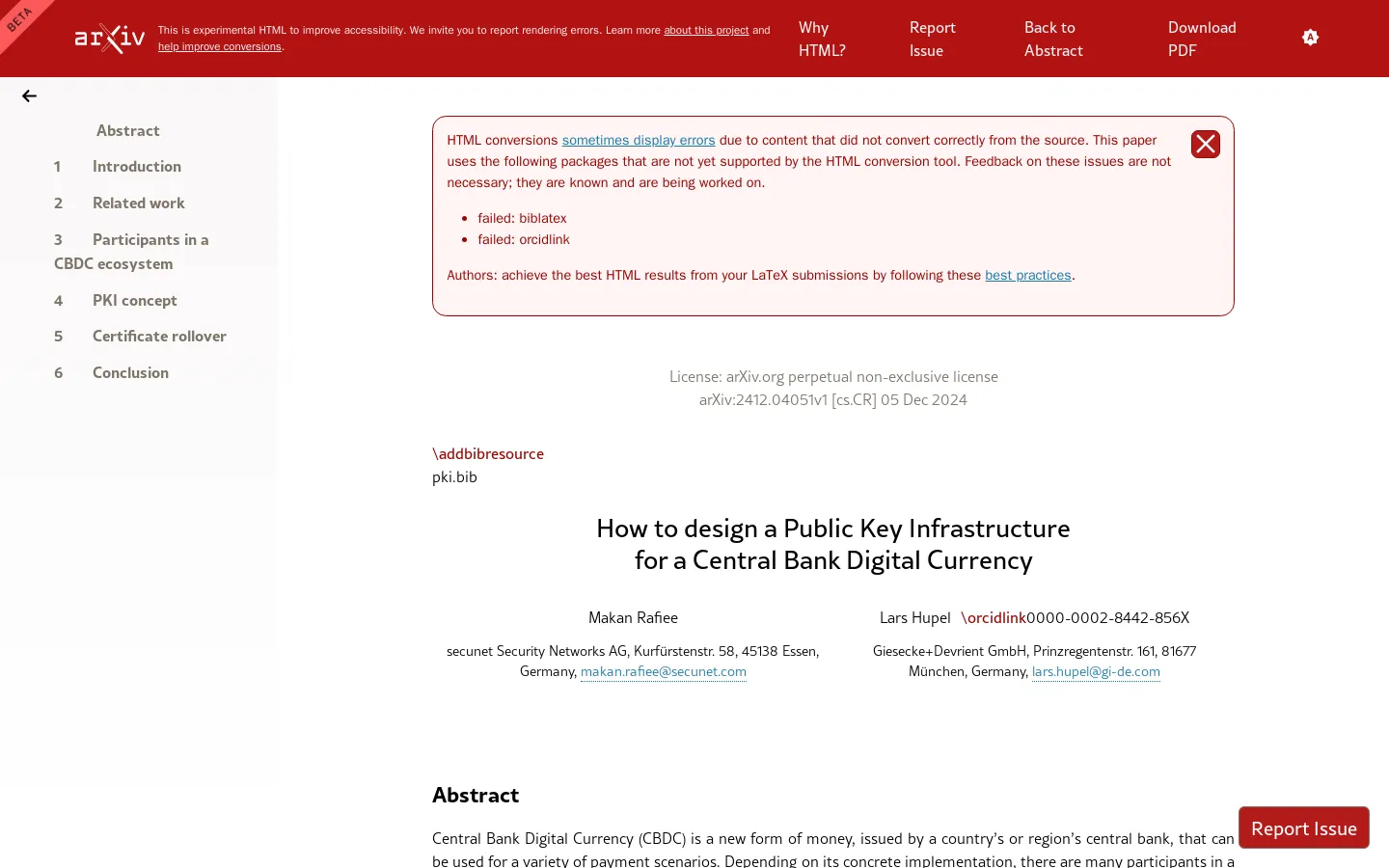
Designing a Public Key Infrastructure for CBDCs
/ 5 min read
Quick take - Recent advancements in Central Bank Digital Currencies (CBDCs) have led to the development of a tutorial focused on enhancing the functionality, security, and resilience of CBDC systems, including the establishment of a certificate hierarchy, continuous operation, and support for offline transactions.
Fast Facts
-
Certificate Hierarchy Establishment: The tutorial emphasizes creating a clear certificate hierarchy to define roles and responsibilities among stakeholders, enhancing transparency and accountability in CBDC operations.
-
Continuous Operation Assurance: A certificate rollover concept is introduced to ensure uninterrupted functionality of the Public Key Infrastructure (PKI), particularly for offline-capable hardware wallets.
-
Security and Resilience Focus: High security and resilience standards are prioritized to meet or exceed those of traditional payment systems, fostering public trust in digital currencies.
-
Offline Transaction Support: The tutorial outlines requirements for PKI to facilitate secure transactions in offline scenarios, addressing the needs of users in areas with limited internet access.
-
Best Practices for PKI Design: Recommendations include establishing a clear certificate hierarchy, implementing robust revocation procedures, ensuring scalability, and focusing on user education to enhance the effectiveness of the CBDC infrastructure.
Advancements in Central Bank Digital Currency (CBDC) Security: A Comprehensive Tutorial
In the rapidly evolving landscape of digital finance, Central Bank Digital Currencies (CBDCs) are emerging as a pivotal innovation. To bolster their functionality and security, a new tutorial has been launched, focusing on key objectives that aim to enhance the operational integrity of CBDCs. This initiative is crucial for ensuring that digital currencies can be trusted by users and integrated seamlessly into existing financial systems.
Establishing a Certificate Hierarchy
One of the primary goals of the tutorial is to establish a structured certificate hierarchy within the CBDC ecosystem. This hierarchy is essential for delineating the roles and responsibilities of various stakeholders, including central banks, financial service providers, and end-users. By clearly defining these roles, the initiative seeks to improve transparency and accountability, which are vital for the smooth operation of CBDCs.
Ensuring Continuous Operation
A significant component of the tutorial is the development of a certificate rollover concept. This concept is designed to ensure the uninterrupted functionality of the Public Key Infrastructure (PKI), which is critical for secure transactions and verification processes. The tutorial addresses challenges posed by offline-capable hardware wallets, ensuring that users can rely on the system without disruptions.
Addressing Security and Resilience
Security and resilience are at the forefront of this tutorial. The emphasis is on meeting or exceeding traditional national payment infrastructure standards. High security standards are crucial for building public trust in digital currencies, as users need assurance that their transactions and personal data are protected against potential threats.
Facilitating Offline Transactions
Recognizing the demand for offline-capable wallets, the tutorial outlines specific requirements to support secure transactions even when devices are not connected to the internet. This capability is vital for users in areas with limited internet access or during emergencies when online connectivity may be disrupted.
Key Steps in Designing a PKI for CBDC
The tutorial provides a detailed roadmap for designing and implementing a robust PKI framework for CBDCs:
-
Assessment of Security Requirements: Identifying potential threats and vulnerabilities is crucial. This step involves determining the level of assurance required for various transactions and user identities within the CBDC environment.
-
Key Management Strategy: Developing a robust strategy for generating, distributing, storing, and retiring cryptographic keys is essential. Secure key management maintains the integrity and trustworthiness of the CBDC system.
-
Certificate Authority (CA) Setup: Establishing a credible CA is critical for issuing digital certificates that verify identities within the CBDC ecosystem. The CA must operate with high security standards to foster user trust.
-
Implementation of User Authentication Protocols: Strong authentication protocols ensure that only authorized users can access the CBDC system. Methods such as multi-factor authentication and biometric verification can enhance security further.
Best Practices for Enhancing PKI Design
To optimize PKI design for CBDCs, several best practices should be considered:
-
Establish a Clear Certificate Hierarchy: A well-defined hierarchy simplifies certificate management and enhances trust within the system.
-
Implement Robust Revocation Procedures: Effective procedures like Certificate Revocation Lists (CRLs) or Online Certificate Status Protocol (OCSP) help maintain system integrity by quickly invalidating compromised certificates.
-
Design for Offline Capabilities: Incorporating offline capabilities ensures resilience in environments with limited connectivity.
-
Focus on Scalability and Performance: As CBDC adoption grows, scalable infrastructure is necessary to handle increased transaction volumes without compromising performance.
Avoiding Common Pitfalls
When implementing a PKI for CBDCs, it is important to avoid pitfalls such as inadequate risk assessments, insufficient integration with existing financial frameworks, neglecting user education, overlooking scalability, and failing to establish clear governance policies. Proactive measures like thorough planning and continuous monitoring can mitigate these risks.
By following these guidelines and integrating recommended tools such as RFC 3647 frameworks, Card Verifiable Certificates, OCSP protocols, and Certification Practice Statements (CPS), stakeholders can create a secure and reliable PKI framework that supports effective functioning of CBDCs. This approach not only secures digital transactions but also fosters trust among users, paving the way for broader adoption of digital currencies in today’s financial landscape.



